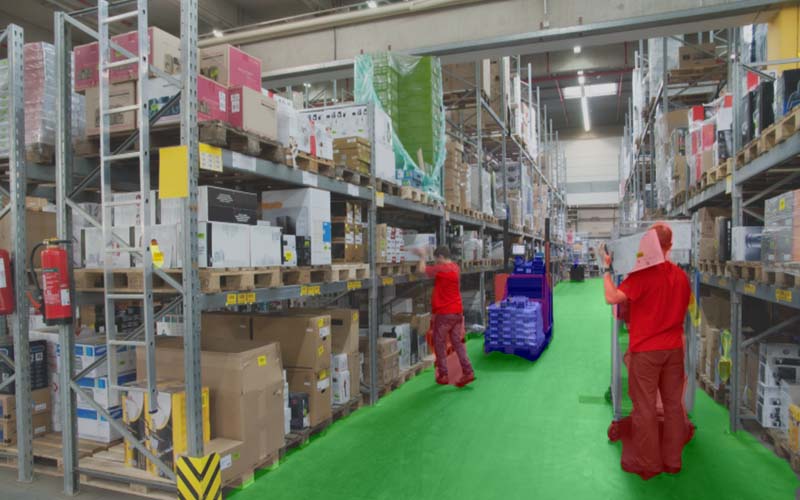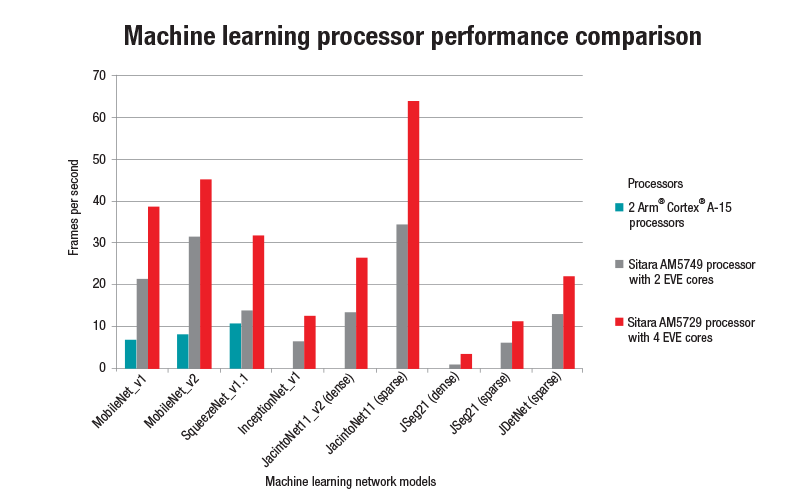SSZT364 december 2019 AM5729 , AM5749
Employing machine learning and neural networks in factories improves applications like machine vision, automated guided vehicles (AGVs) and robotics by making them smarter, which improves operational efficiency. Embedded microcontrollers and processors have been used for decades in manufacturing to automate repetitive processes, but deploying machine-learning algorithms to embedded systems beyond research prototypes is still in its infancy.
Let’s take a look at one application of machine learning in a factory. Today, AGVs receive input from sensors such as cameras or radar. Software running on a processor analyzes the data and makes decisions that control the electric motors and move the AGV around the factory safely. In a constrained environment like a warehouse, classical machine-vision algorithms can be successful, but machine learning can outperform them because can adapt to slight changes in such environments and enable more human-like perception and classification, which is critical as factories evolve to meet three key needs:
- Reduced navigation space as warehouse density increases.
- The ability to classify objects on the factory floor, not just detect them.
- The coexistence of AGVs in a shared space with humans.
How machine learning enables Industry 4.0
Machine learning inference is a powerful tool for processing and understanding information, specifically in machine vision, where it has been shown to outperform not only classical algorithms, but also humans in terms of accuracy. Such capabilities are achieved through deep learning, which is a subset of machine learning that uses deep neural networks trained with a large amount of data.
Deploying machine learning in an industrial embedded system
The inference capabilities of a machine-learning-enabled processor apply the knowledge of a trained network to a given image or frame in a sequence of images. TI Sitara™ processors are embedded inference processors that enable equipment manufacturers to deploy machine-learning algorithms and automate applications like machine vision for AGVs.
 Figure 1 An example to illustrate the
role of labeled data and machine learning
Figure 1 An example to illustrate the
role of labeled data and machine learningTo illustrate how an AGV might operate, we used the jsegnet21v2 network from TI’s processor software development kit (SDK) on an image applicable to AGVs in a warehouse setting. The example is trained on the cityscapes data set; for a production AGV, you would need to collect and label the pictures applicable to your environment to train the selected network.
Using the TI deep learning (TIDL) software framework, I deployed our algorithm on the Sitara AM5729 processor. The AM5729 processor ran the algorithm on a 1,024-by-512 pixel frame at about a dozen frames per second using the four embedded vision engine (EVE) cores on the device, and consumed less than 0.5 W of additional power. Each of the four EVE cores is a coprocessor able to perform 512-bit-wide vector multiply-accumulate operations that dominate the computational needs of neural networks. In real-time cyberphysical systems like AGVs, latency matters as well as throughput (frames per second). The frame processing latency on the AM5729 is approximately 250 ms (four frames in parallel), very likely sufficient to make decisions regarding the velocity of an AGV in a warehouse.
Reducing latency in machine-learning inference
In a typical example classification application using a network model like MobileNetv2, the high frame rate with low batch size achievable with the AM5729 translates to a 30%-40% decrease in inference latency per frame compared to the AM5749, which has two EVE cores. MobileNetv2 classification on 224-by-224-pixel images can run at 45 frames per second on the AM5729 processor. With less than 2 percentage point accuracy compromise, sparsification and TI’s EVE-optimized deep-learning network model JacintoNet11, it is possible to improve the inference latency even further.
 Figure 2 Frames-per-second performance
of processors across various machine-learning networks
Figure 2 Frames-per-second performance
of processors across various machine-learning networksToday’s distributed factories and breadth of applications will require machine-learning inference algorithms built on popular platforms like Sagemaker NEO and TensorFlow Lite that can run using the various network models listed in Figure 2. The ability to support these popular platforms is critical to manage the use of machine-learning inference everywhere as factory automation evolves.
Conclusion
Industrial embedded applications are about solving real-time use cases in the physical world, that can be proven with digital micro-benchmarks like frames-per-second throughput. In practice, the performance of the Sitara AM5729 processor enables the processing of typical camera inputs in real time, with frame rate, latency and power consumption relevant to multiple factory applications. To evaluate machine-learning functions with the AM5729 processor, the BeagleBone AI evaluation board offers a low-cost option for getting started, and the TMDSIDK572 IDK offers a full-featured, industrial-grade evaluation board for building and testing machine learning applications.